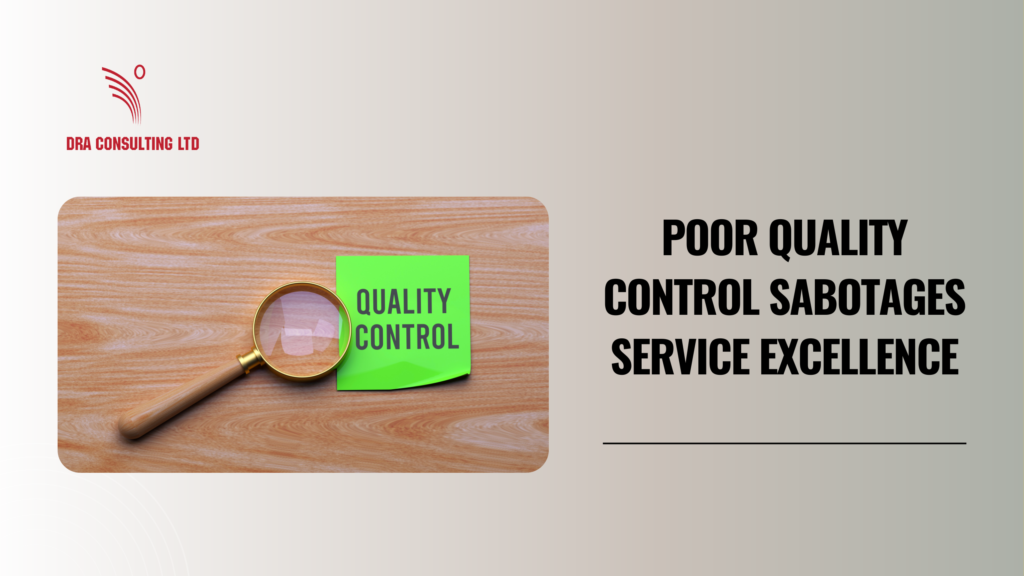Quick question. What happens when a business introduces a new process, but fails to implement a system for monitoring the correct application of the steps in the process? In a word….confusion. The result is a widely varying set of practices, that ultimately lose any resemblance to the original intention of improving the user’s experience.
At the heart of quality control, is the need to sustain desired outcomes, to maximize existing business, to pre-empt lost business, and to ensure that ultimately, the customer’s experience is in sync with the customer’s expectations. For me, pre-empting lost business should be a huge motivator for businesses to onboard surveillance systems, given that quite a bit of business leakage occurs due to sloppy service delivery.
For me, pre-empting lost business should be a huge motivator for businesses to onboard surveillance systems, given that quite a bit of business leakage occurs due to sloppy service delivery.
One of the challenges associated with service delivery and customer experience is that businesses don’t understand just how important a lever quality control is, in driving service excellence. As a result, these businesses become laggards in adopting the practices that sustain unvarying service delivery.
“Application by personality” happens when a business leaves it up to its employees to drive a process. The process becomes driven by the vagaries of people’s moods, performance standards, personal issues, supportive or adverse feelings about the process, or lack of understanding of the content.
Recently, I had the experience of interacting with an employee at one of the branches of a business. She went through the perfunctory motions, in a very robotic way, with no infusion of the kind of energy that drives an emotional connection with the customer. Whilst I am what you can call a very particular type of customer, I don’t think that I am over reacting to this transactional experience.
Without sustained surveillance systems, employees will serve customers according to their whims and fancies, since no one is monitoring the delivery standards. Call it “application by personality.”
So, my thinking on the situation that I encountered is that, without sustained surveillance systems, employees will serve customers according to their whims and fancies, since no one is monitoring the delivery standards. Call it “application by personality.” This employee was left on her own to apply the customer engagement process and she failed spectacularly. Had she been under more close surveillance, there’s a good chance that my experience may have been more enjoyable.
Moreover, as part of my transaction process, I shared my email address and mobile number. A simple way of tracking my experience would have been to shoot me an (automated) message asking if the experience met my expectations.
Businesses verbalize their desire to deliver a great customer experience and of course, many invest in human resource development, automated processes and digital solutions to support the great service delivery intention. What is disappointing is the widespread disregard for being obsessive about adding the quality control components of reinforcement, surveillance and monitoring systems, to drive compliance with delivery standards.
Surveillance becomes even more imperative for those businesses with multiple branches, contact centres, over the counter services and e-commerce platforms.
Surveillance becomes even more imperative for those businesses with multiple branches, contact centres, over the counter services and e-commerce platforms. Remember the old adage… “What gets measured gets done?” I would modify this adage slightly, to say, “What gets reinforced, monitored and measured, gets perfected.” The reality is that in many businesses, there is an effort threshold that is dedicated to supporting and sustaining service delivery. Getting businesses to go beyond this effort “set point” becomes a herculean effort. What’s troubling is that in some cases, this threshold may be based not on scientific insight, but on sentiment.
When it comes to employee training and development, some businesses follow the lazy route and expose their employees to a one or two-day, training program and then expect full and flawless execution of all that was taught in the program. Employees are left on their own, with little or no coaching, monitoring, progress reporting, or behaviour modification feedback. Quality of service is therefore, compromised. My encounter with the customer service representative should come to mind here.
We’re all familiar with the advisory that “the call may be monitored for service quality.” This works efficiently if a supervisor is fully dedicated to conversation monitoring, so that he or she can de-escalate and salvage calls that are at risk of impairment.
Let me make a quick comment on contact centres. We’re all familiar with the advisory that “the call may be monitored for service quality.” This works efficiently if a supervisor is fully dedicated to conversation monitoring, so that he or she can de-escalate and salvage calls that are at risk of impairment. I’m guessing that many businesses waive the “full-dedication” of supervisory time to call eavesdropping. Again, compromising quality.
So, do I believe that we’ll be seeing a shift in quality control effort amongst businesses to drive and sustain great customer outcomes?
Yes. Why? Because the days of customers accepting wildly varying service quality are coming to an end.

